vowels
- 格式:ppt
- 大小:160.50 KB
- 文档页数:24

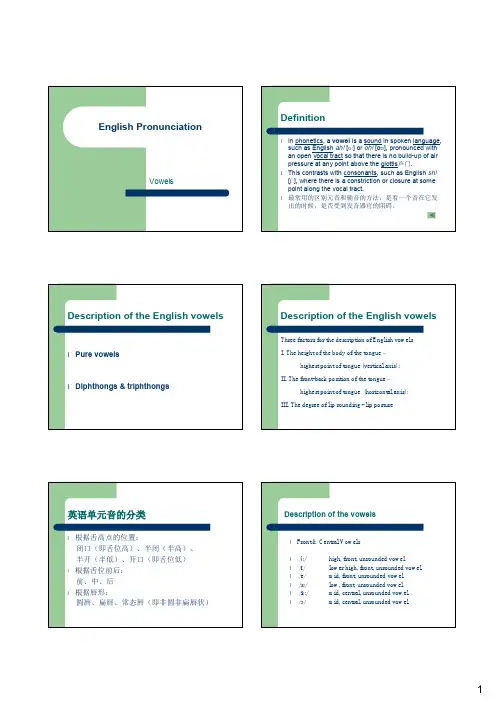
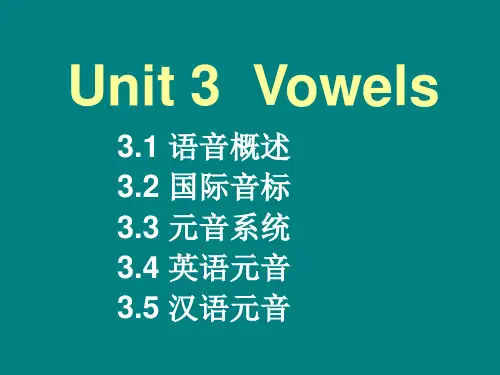
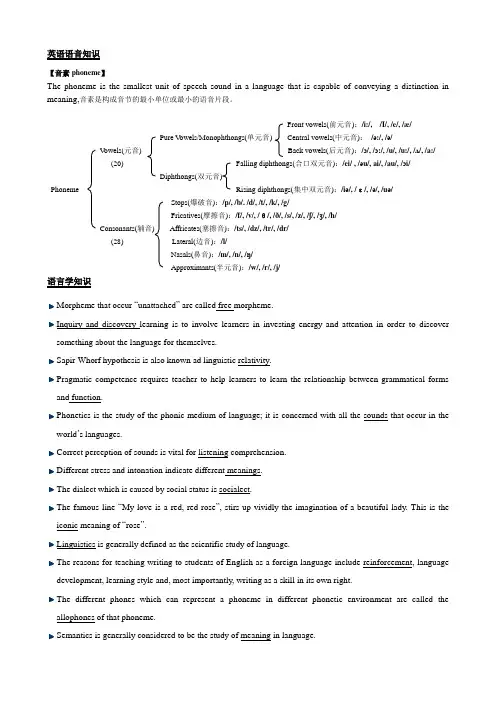
英语语音知识【音素phoneme】The phoneme is the smallest unit of speech sound in a language that is capable of conveying a distinction in meaning,音素是构成音节的最小单位或最小的语音片段。
Front vowels(前元音):/i:/, /I/, /e/, /æ/Pure V owels/Monophthongs(单元音) Central vowels(中元音):/ə:/, /ə/V owels(元音) Back vowels(后元音):/ɔ/, /ɔ:/, /u/, /u:/, /ʌ/, /a:/(20) Falling diphthongs(合口双元音):/ei/ , /əu/, ai/, /au/, /ɔi/Diphthongs(双元音)Phoneme Rising diphthongs(集中双元音):/iə/, /ε/, /ə/, /uə/Stops(爆破音):/p/, /b/. /d/, /t/, /k/, /g/Fricatives(摩擦音):/f/, /v/, /θ/, /ð/, /s/, /z/, /ʃ/, /ʒ/, /h/Consonants(辅音) Affricates(塞擦音):/ts/, /dz/, /tr/, /dr/(28) Lateral(边音):/l/Nasals(鼻音):/m/, /n/, /ŋ/Approximants(半元音):/w/, /r/, /j/语言学知识Morpheme that occur “unattached” are called free morpheme.Inquiry and discovery learning is to involve learners in investing energy and attention in order to discoversomething about the language for themselves.Sapir-Whorf hypothesis is also known ad linguistic relativity.Pragmatic competence requires teacher to help learners to learn the relationship between grammatical formsand function.Phonetics is the study of the phonic medium of language; it is concerned with all the sounds that occur in theworld’s languages.Correct perception of sounds is vital for listening comprehension.Different stress and intonation indicate different meanings.The dialect which is caused by social status is socialect.The famous line “My love is a red, red rose”, stirs up vividly the imagination of a beautiful lady. This is theiconic meaning of “rose”.Linguistics is generally defined as the scientific study of language.The reasons for teaching writing to students of English as a foreign language include reinforcement, languagedevelopment, learning style and, most importantly, writing as a skill in its own right.The different phones which can represent a phoneme in different phonetic environment are called theallophones of that phoneme.Semantics is generally considered to be the study of meaning in language.。
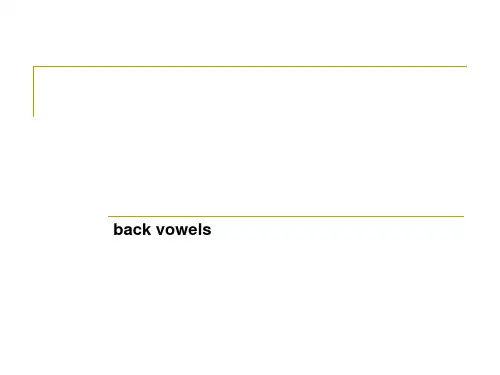
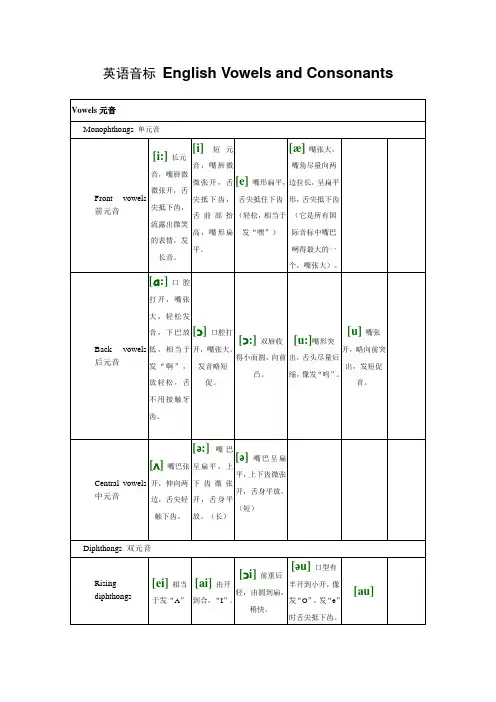
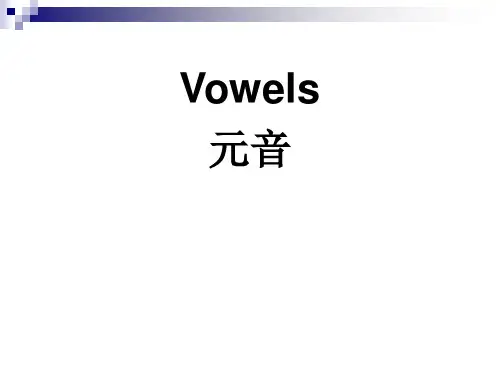

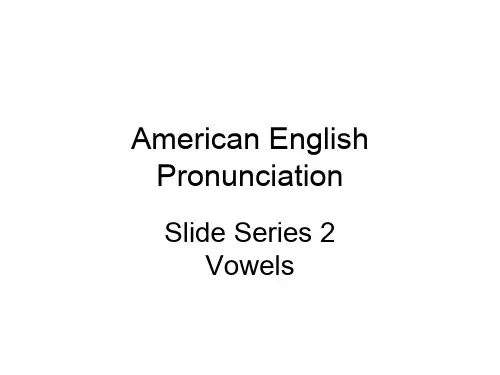
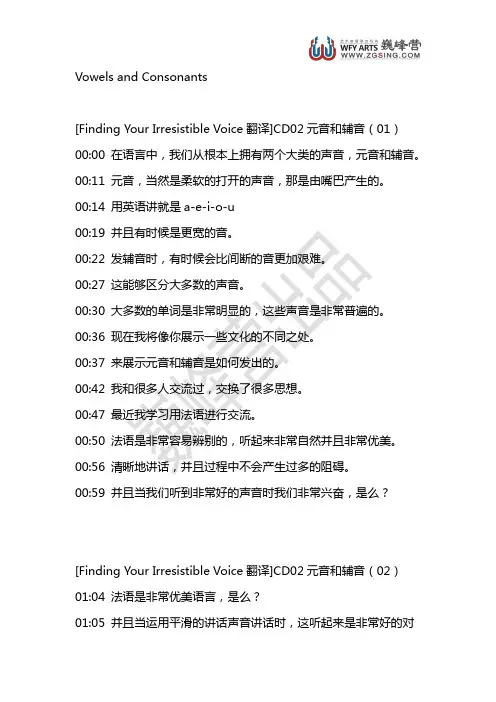
Vowels and Consonants[Finding Your Irresistible Voice翻译]CD02元音和辅音(01)00:00在语言中,我们从根本上拥有两个大类的声音,元音和辅音。
00:11元音,当然是柔软的打开的声音,那是由嘴巴产生的。
00:14用英语讲就是a-e-i-o-u00:19并且有时候是更宽的音。
00:22发辅音时,有时候会比间断的音更加艰难。
00:27这能够区分大多数的声音。
00:30大多数的单词是非常明显的,这些声音是非常普遍的。
00:36现在我将像你展示一些文化的不同之处。
00:37来展示元音和辅音是如何发出的。
00:42我和很多人交流过,交换了很多思想。
00:47最近我学习用法语进行交流。
00:50法语是非常容易辨别的,听起来非常自然并且非常优美。
00:56清晰地讲话,并且过程中不会产生过多的阻碍。
00:59并且当我们听到非常好的声音时我们非常兴奋,是么?[Finding Your Irresistible Voice翻译]CD02元音和辅音(02)01:04法语是非常优美语言,是么?01:05并且当运用平滑的讲话声音讲话时,这听起来是非常好的对么?01:13说这种语言的时候可能是非常平滑的或者是突然中止的。
01:15并且除了这些主要部分你发现自己仍然拥有很多的幸福时光。
01:19当他们讲到爱情和安静地唱歌时会更好。
01:23这只是来自于你发出元音和辅音的方式。
01:26你也许可以找到愉快的感觉。
01:31我也许会听到一点点,但是我认为你可以理解这一点。
01:35一会儿我将会讲解法语的不同发音方式。
01:38现在注意相关细节。
01:43通过二十年时间形成的课程中,经历了很长时间的努力和学习。
01:46已经在主题报告中消耗。
01:47并且报告对于有效的交流场合是非常重要的。
[Finding Your Irresistible Voice翻译]CD02元音和辅音(03)01:53我希望你知道这个难以置信的关键,保持增加深度水平的报告的水平。

48个国际音标发音大全(发音方法及口诀)国际音标是一种标音符号,用于表示声音发音的方式。
以下是48个国际音标发音大全及其发音方法和口诀:元音(Vowels):1. /i/ - 发“ee”,如“see” - Keep your teeth together and smile.2. /ɪ/ - 发“ih”,如“sit” - Open your mouth and say “ih”.3. /e/ - 发“ay”,如“say” - Smile and say “ay”.4. /æ/ - 发“a”,如“cat” - Open your mouth and say “a”.5. /ɑ/ - 发“ah”,如“hot” - Open your mouth wide and say “ah”.6. /ʌ/ - 发“uh”,如“cup” - Open your mouth slightly and say “uh”.7. /ɔ/ - 发“aw”,如“law” - Open your mouth and say “aw”.8. /o/ - 发“oh”,如“go” - Open your mouth and say “oh”.9. /u/ - 发“oo”,如“book” - Pout and say “oo”.10. /ʊ/ - 发“ooh”,如“good” - Round your lips and say “ooh”.双元音(Diphthongs):11. /eɪ/ - 发“ey”,如“play” - Start with “ay” and glide to an “ee” sound.12. /aɪ/ - 发“uy”,如“buy” - Start with “uh” and glide to an “ee” sound.13. /ɔɪ/ - 发“oy”,如“boy” - Start with “aw” and glide to an “ee” sound.14. /oʊ/ - 发“oh”,如“boat” - Start with “aw” and glide to an “oo” sound.15. /aʊ/ - 发“ow”,如“cow” - Start with “uh” and glide to an “oo” sound.16. /ɪə/ - 发“eer”,如“beer” - Start with “ih” and glide to an “uh” sound.17. /eə/ - 发“air”,如“care” - Start with “ay” and glide to an “uh” sound.18. /ʊə/ - 发“oor”,如“poor” - Start with “ooh” and glide to an “uh” sound. 浊辅音(Voiced Consonants):19. /b/ - 发“b”,如“book” - Place your lips together and say “b”.20. /d/ - 发“d”,如“dog” - Place the tip of your tongue on the roof of your mouth and say “d”.21. /g/ - 发“g”,如“go” - Place the back of your tongue against the soft part of your mouth and say “g”.22. /v/ - 发“v”,如“very” - Place your upper teeth on your lower lip and say “v”.23. /z/ - 发“z”,如“zoo” - Place the tip of your tongue behind your top front teeth and say “z”.24. /ʒ/ - 发“zh”,如“pleasure” - Place the tip of your tongue behind your top front teeth and say “zh”.25. /dʒ/ - 发“j”,如“job” - Place the tip of your tongue behind your top front teeth and say “j”.26. /m/ - 发“m”,如“man” - Close your lips and say “m”.27. /n/ - 发“n”,如“no” - Put the tip of your tongue on the roof of your mouth and say “n”.28. /ŋ/ - 发“ng”,如“sing” - Close your throat and say “ng”.29. /l/ - 发“l”,如“love” - Place the tip of your tongue behind your top front teeth and say “l”.30. /r/ - 发“r”,如“run” - Curl your tongue back slightly and say “r”.31. /j/ - 发“y”,如“yes” - Place the middle of your tongue on the roof of your mouth and say “y”.32. /w/ - 发“w”,如“way” - Round your lips and say “w”.清辅音(Voiceless Consonants):33. /p/ - 发“p”,如“park” - Close your lips and say “p”.34. /t/ - 发“t”,如“time” - Put the tip of your tongue on the roof of your mouth and say “t”.35. /k/ - 发“k”,如“key” - Place the back of your tongue against the soft part of your mouth and say “k”.36. /f/ - 发“f”,如“fun” - Place your lower lip against your upper teeth and say “f”.37. /θ/ - 发“th”,如“think” - Put your tongue between your teeth and say “th”.38. /s/ - 发“s”,如“sun” - Put the tip of your tongue behind your top front teeth and say “s”.39. /ʃ/ - 发“sh”,如“she” - Place the tip of your tongue behind your top front teeth and say “sh”.40. /tʃ/ - 发“ch”,如“cheese” - Place the tip of your tongue behind your top front teeth and say “ch”.41. /h/ - 发“h”,如“hug” - Breathe out and say “h”.42. /ɸ/ - 发“f”,如“far” - Place your upper teeth on your lower lip and say “f”.43. /θ̠/ - 发“th”,如“thick” - Touch the tip of your tongue to the bottom of your bottom front teeth and say “th”.44. /ç/ - 发“j”,如“hue” - Place the middle of your tongue on the roof of your mouth and say “j”.45. /x/ - 发“h”,如“loch” - Place the back of your tongue against the soft part of your mouth and say “h”.46. /h/ - 发“h”,如“hue” - Breathe out and say “h”.47. /ʔ/ - 发“uh”,如“uh-oh” - Close your throat and say “uh”.48. /j/ - 发“y”,如“yes” - Place the middle of your tongue on the roof of your mouth and say “y”.这些是48个国际音标的发音方法和口诀。
语音的基本概念Ⅰ字母是语言的书写形式。
1、元音字母:又叫母音字母,是指语言里起着发声作用的字母。
英语26个字母中,有5个元音字母a, e, i, o, u。
字母y后无元音字母时,充当元音字母,发音与i相同,称为半元音字母;作为辅音发/j/,作为元音发/i/。
元音字母在重读开音节中发长音,在重读闭音节中发短音。
一般说来,元音字母发元音,但有时也不发音(e),而两个元音字母组合在一起时常常发一个元音,所以,音节的个数以音标中的元音个数来判断。
2、辅音字母:除元音字母外其余的都是辅音字母,辅音字母在单词中发音比较单一,不随音节变化而变化。
a. 元音字母组合:aar, ae, ai, air, aor, ar, are, au, aw, ay, ea, ear, eau, ee, eer, ei, eir, eo, er, ere, eu, eur, ew, ey, ia, iar, ie, ier, iew, io, ior, iou, ir, ire, iu, oa, oar, oe, oi, oir, oo, oor, ore, ou, ough, our, ow, oy, ua, uar, ue, uer, ui, uou, ur, ure, uu, uy, ya, ye, yer, yi, yo, yr, yreb. 辅音字母组合:bb, cc, ch, ck, d, dge, dj, ff, gg, gh, gu, ll, mm, nn, ph, pp, qu, rr, sc, sch, sci, sh, si, ss, tch, ti, th, tt, sh, xc, zzb. 混合字母组合:sion, sure, tion, tureⅡ音素是语音的最小的单位。
音素分为元音和辅音,英语中有48个音素,元音音素20个,辅音音素28个。
Ⅲ每一个单词都有语音形式和书写形式。
音标就是语言的语音标记,是词的语音形式。
48个英语国际音标发音教学英语国际音标(International Phonetic Alphabet,简称IPA)是一种用来表示语音的国际标准符号系统。
掌握英语国际音标的发音规则,可以帮助学习者准确地发音,并提高听力理解能力。
本文将针对48个英语国际音标的发音进行详细教学。
1. 单元音(Vowels)英语国际音标中的单元音共有20个,它们分布在嘴巴不同位置,并有不同的舌位和口型。
(1) [i]音(bit):舌位较高,口型偏闭,嘴巴微微张开,发音时会有“eee”的感觉。
(2) [ɪ]音(hit):舌位较低,口型偏开,嘴巴稍稍张开,发音时会有“ihh”的感觉。
(3) [e]音(bet):舌位中等,口型偏开,嘴巴中等张开,发音时会有“ehh”的感觉。
(4) [æ]音(cat):舌位较低,口型偏开,嘴巴更大地张开,发音时会有“ahh”的感觉。
(5) [ɑ]音(car):舌位较低,口型偏开,嘴巴最大地张开,发音时会有“aa”的感觉。
(6) [ɔ]音(song):舌位较低,口型偏开,嘴巴微微张开,发音时会有“aw”的感觉。
注意:以上6个音在发音时均需保持嘴巴微张开的状态,不要过分收敛或张开,以保证发音准确。
(7) [ʊ]音(book):舌位较低,口型偏闭,产生一个轻微收音的感觉。
(8) [u]音(boot):舌位较高,口型偏闭,发音时会有“oo”的感觉。
(9) [o]音(boat):舌位较低,口型偏开,嘴巴稍稍张开,发音时会有“oh”的感觉。
(10) [ə]音(about):舌位中等,口型偏开,嘴巴稍稍张开,发音时会有“uh”的感觉。
(11) [ʌ]音(bus):舌位较低,口型偏开,嘴巴微微张开,发音时会有“uhh”的感觉。
(12) [ɜ:]音(bird):舌位中等,口型偏闭,发音时会有“err”的感觉。
(13) [ɪə]音(hear):舌位中等,口型偏开,嘴巴稍稍张开,发音时会有“i-uh”的感觉。
48个国际音标详细教程国际音标(IPA)是一种用于标记语音音素的国际通用符号系统,它被广泛应用于不同的语言学领域。
学习国际音标可以帮助我们准确地发音和理解不同语言中的音素。
下面是一个关于国际音标的详细教程,详细介绍了48个国际音标符号及其对应的发音。
前元音(Front vowels):1. /i/:高前不圆音,如英语的"sheep",读作/iː/。
2. /ɪ/:低前不圆音,如英语的"ship",读作/ʃɪp/。
3. /e/:半开前不圆音,如英语的"red",读作/red/。
4. /ɛ/:开前不圆音,如英语的 "pen",读作/pen/。
5. /æ/:开前不圆短音,如英语的 "cat",读作/kæt/。
央元音(Central vowels):6. /ə/:中央非圆元音,如英语的"about",读作/əˈbaʊt/。
后元音(Back vowels):7. /u/:高后圆元音,如英语的"boot",读作/buːt/。
8. /ʊ/:低后圆元音,如英语的"hood",读作/əʊdz/。
9. /ʌ/:开后不圆元音,如英语的"up",读作/ʌp/。
10. /ɔ/:半开后圆元音,如英语的"law",读作/lɔː/。
11. /ɒ/:开后圆音,如英语的"log",读作/lɒɡ/。
高元音(High vowels):12. /ɪə/:低高前不圆双元音,如英语的"ear",读作/ɪər/。
13. /eɪ/:高前不圆双元音,如英语的"day",读作/deɪ/。
14. /aɪ/:高前不圆双元音,如英语的"like",读作/aɪk/。
英语作文字母正确发音规则In English, the pronunciation of letters can vary depending on their context within words and the influence of adjacent letters. Understanding the correct pronunciation rules is crucial for accurate communication. Below, I'll delve into the rules governing the pronunciation of English letters:1. Vowels:A: It has two primary pronunciations. The short sound, as in "cat" or "bat," is like "æ," while the long sound, as in "cake" or "late," is like "eɪ."E: It can be pronounced as "ɛ" as in "bed" or "eɪ" as in "be."I: It can be pronounced as "ɪ" as in "sit" or "aɪ" as in "mine."O: It can be pronounced as "ɒ" as in "hot" or "oʊ" as in "go."U: It can be pronounced as "ʌ" as in "cup" or"juː" as in "cute."Y: It can function as both a consonant and a vowel. As a vowel, it often takes on the sounds of "ɪ" as in "gym" or "aɪ" as in "myth."2. Consonants:B: Pronounced as "bi" with a soft "b" sound.C: Has two primary sounds, "k" as in "cat" or "s" as in "city."D: Pronounced as "di" with a soft "d" sound.F: Pronounced as "ɛ f."G: Has two primary sounds, "g" as in "goat" or "dʒ"as in "giant."H: Pronounced as "eɪʧ."J: Pronounced as "dʒeɪ."K: Pronounced as "keɪ."L: Pronounced as "ɛl."M: Pronounced as "ɛm."N: Pronounced as "ɛn."P: Pronounced as "pi."Q: Always followed by "u" in English, pronounced as "kju."R: Pronounced as "ɑr."S: Pronounced as "ɛs."T: Pronounced as "ti."V: Pronounced as "vi."W: Pronounced as "ˈdʌbəlju."X: Can have multiple pronunciations, such as "ɛks" or "z."Z: Pronounced as "zi."3. Combination Sounds:Ch: Pronounced as "tʃ" as in "church."Sh: Pronounced as "ʃ" as in "shoe."Th: Has two sounds, "θ" as in "think" or "ð" as in "this."Ng: Pronounced as "ŋ" as in "sing."Wh: Pronounced as "w" as in "what."Ph: Pronounced as "f" as in "phone."Kn: Pronounced as "n" as in "knee."Gn: Pronounced as "n" as in "gnome."4. Silent Letters:Some letters are silent in certain words, such as the "h" in "hour" or the "k" in "knife."5. Schwa Sound:The schwa sound, represented by the symbol "ə," is a neutral vowel sound often found in unstressed syllables, such as the second syllable in "banana" or the first syllable in "sofa."6. Accent Variations:English accents, such as British English and American English, may pronounce certain letters and combinations differently. For example, the pronunciation of the letter "r" varies between these accents.7. Loan Words:English borrows words from various languages, which may retain their original pronunciation. For instance, "rendezvous" retains the French pronunciation of"rɑ̃devu."Mastering the pronunciation of English letters involves understanding these rules and practicing their application in various words and contexts. Additionally, exposure to spoken English through listening and conversation can greatly aid in improving pronunciation skills.。